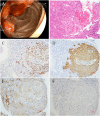Case report: Advanced primary squamous cell carcinoma in the periampullary area with upregulation of programmed cell death-ligand 1 expression and response to sintilimab immunotherapy
- PMID: 36776865
- PMCID: PMC9911421
- DOI: 10.3389/fimmu.2023.1086760
Case report: Advanced primary squamous cell carcinoma in the periampullary area with upregulation of programmed cell death-ligand 1 expression and response to sintilimab immunotherapy
Abstract
Primary squamous cell carcinoma (SCC) of the periampullary area is exceedingly rare. We report a case of a 45-year-old woman who presented with progressive upper abdominal pain and melena. Laboratory testing revealed an elevated level of carcinoembryonic antigen. Esophagogastroduodenoscopy revealed a very large irregular ulcerated tumor in the periampullary area. Contrast-enhanced computed tomography (CT) of the chest, abdomen, and pelvis, 18 F-fluorodeoxyglucose positron emission tomography/CT, and thin-prep cytologic test excluded metastasis of the primary tumor to the periampullary area from other sites. Immunohistochemistry revealed positive p40 and cytokeratin (CK)5/6, indicating SCC. The expression of programmed cell death-ligand 1 (PD-L1) in tumor cells was upregulated, and the patient responded well to chemotherapy combined with immunotherapy. To the best of our knowledge, this is the first reported case of advanced primary SCC in the periampullary area with high expression of PD-L1.
Keywords: immunotherapy; periampullary; primary; programmed cell death-ligand 1; sintilimab; squamous cell carcinoma.
Copyright © 2023 Wang, Li, Zeng, Wang and Jiang.
Conflict of interest statement
The authors declare that the research was conducted in the absence of any commercial or financial relationships that could be construed as a potential conflict of interest.
Figures



References
-
- Hayley H, Amin S, Natalee T, Madappa K. Progression of metastatic, PD-L1–positive, ampullary carcinoma with a treatment holiday from off-label use of pembrolizumab therapy. J Hematol Oncol Pharm (2020) 10(4):224–7.
-
- Rajapakse A, Malewana E, Jayasinghe J, Kailasapathy B, Pathirana A, Prematilleke I. Squamous cell carcinoma of the ampulla of vater – a case report. Proc Sci Sessions FMS USJP (2015), 10:PP19.
Publication types
MeSH terms
Substances
LinkOut - more resources
Full Text Sources
Research Materials
Miscellaneous

